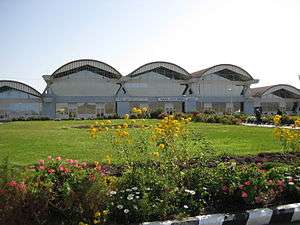Mekelle
Mekelle (Tigrinya: መቐለ, mäqälle, Amharic: መቀሌ, mek’elē, Italian: Macallé), or Mekele, formerly the capital of Enderta awraja in Tigray, is today the capital city of Tigray National Regional state.[2] It is located around 780 kilometres (480 mi) north of the Ethiopian capital Addis Ababa, with an elevation of 2,254 metres (7,395 ft) above sea level. Administratively, Mekelle is considered a Special Zone, which is divided into seven sub-cities. Mekelle is the economic, cultural, and political hub of northern Ethiopia.
Mekelle መቐለ Mak'allè | |
|---|---|
City | |
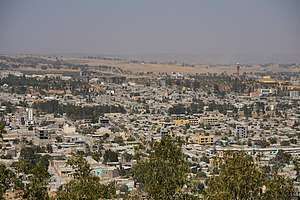 | |
 Flag | |
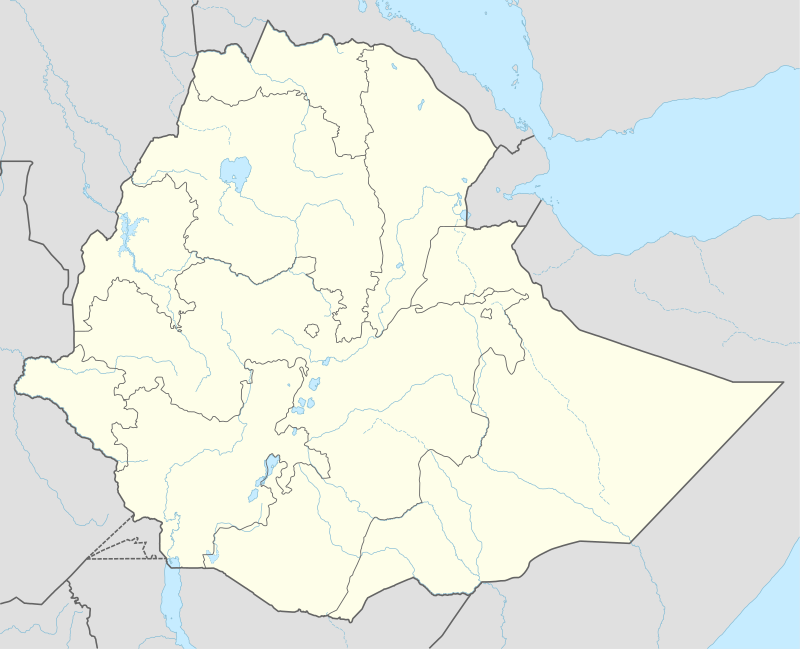 Mekelle Location within Ethiopia | |
| Coordinates: 13°29′N 39°28′E | |
| Country | Ethiopia |
| Region | Tigray |
| Zone | Mekelle Special Zone |
| Government | |
| • Mayor | Araya Grmay |
| • House Representative | Addis Alem Balema |
| Elevation | 2,254 m (7,395 ft) |
| Population (2018) | |
| • Total | 310,436[1] |
| Time zone | UTC+3 (EAT) |
| ZIP Code | List
|
| Area code(s) | (+251) 14 |
| Climate | BSh |
Mekelle has grown rapidly since 1991. In 1984 it had 61,583 inhabitants, in 1994, 96,938 (96.5% being Tigrinya-speakers), and in 2006 169,200 (i.e. 4% of the population of Tigray). Mekelle is 2.6 times larger than Adigrat, the second largest regional center. It is the fifth largest city in Ethiopia, after Addis Ababa, Dire Dawa, Adama, and Gondar. The majority of the population of Mekelle depends on government employment, commerce and small-scale enterprises. Mekelle now has new engineering, cement and textile factories, producing for the local and foreign market. There is a rising university which developed out of the pre-1991 Arid Agricultural College, and about a dozen other governmental and private colleges.[2]
History
Origins
Mekelle is believed to have evolved from a 13th-century hamlet called Enda Meseqel (later Enda Medhane Alem), becoming a town by the early 19th century, when ras Wolde Selassie of Enderta made Antalo his seat of power, and the region of Mekelle (40 kilometres (25 mi) to the north) his recreational center. [3][4] In the tax records of atse Tewodros II, Mekelle appears as a tributary district within Enderta with a negarit of its own.[5]
19th century
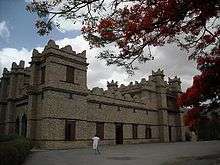
The credit for Mekelle's growth into a regional capital goes to atse Yohannes IV who made Mekelle political capital of his expanding state. He must have chose the place for its strategic proximity both to rich agricultural areas (of Raya Azebo) and to the Afar salt country. Mekelle's position on the route to Shewa, the power base of Yohannes's main rival Menelik could have been another factor. Three institutions still important for modern Mekelle were founded by Yohannes. The grand palace built in 1882-84 by ethiopian engineer Engedashet Schimper (takes as an example the construction technique of other buildings present in the Tigrai at the time of the Axumite kingdom and the buildings of the peasants and sacred churches of the Tigrai) and forms the historic center of Mekelle. The large market Edaga Senuy ("Monday Market"). The church, at Debre Gennet Medhane Alem, built after the return from Raya Azebo campaign in 1871.[6][7][8]
In the 1880s, Mekelle became the Emperor's capital city. Among the factor that further accelerated Mekele's growth and urbanization were the establishment of residential quarters by the "nobility" and court servants, the prominence of the amole salt market and the subsequent establishment of local and foreign trading and occupational communities, and Mekelle'a strategic position as a transit center for commodities of the long-distance trade routes of north eastern Ethiopia, attached to the Red Sea ports, and to northern and central Ethiopia.[9] By establishing a market in Mekelle, Yohannes could draw on the norther trade routes as well as the salt caravan routes to the town, capitalizing on his political leverage.[3]
The succession of atse Menelik II of Shewa signaled a trading reorientation from northern to southern Ethiopia (centered in Shewa). The new capital Addis Ababa quickly outstripped Mekelle, which, however, retained its political importance as the district and regional administration center of Enderta and Tigray respectively through the 20th century, and its economical role in the Ethiopian salt trade.
During the Italian War of 1895–96, Mekelle became an important site in the conflict. After the fall of Adwa in spring 1895, ras Mengasha Yohannes retreated from his father's capital Mekelle following the advice of atse Menelik II. Mekelle was occupied by the Italians without a shot and integrated into the Colonia Eritrea; from here the Italians extended their occupation south, up to Ambalage.[10] The Italian army established their fort near the Enda Eyesus church above Mekelle in October 1895. After the re-occupation of Ambalage in late 1895, the fort was besieged by Ethiopian troops, who cut the Italians' water supply. When the Italians surrendered in January 1896, Menelik allowed them to retreat to their stronghold Adigrat, probably hoping to prevent an escalation of the conflict, and he appointed his own governor over Enderta at Mekelle, dejazmach Tedla Abaguben, in order to check the rebellious Tigrayan princes.
20th century
Three historical epochs sustained Mekelle's urbanization in the 20th century. The first was the advent of dejazmach Abreha Araya Demsu, governor of Eastern Tigray with Mekelle as his capital. Abreha imitated his cousin Yohannes by establishing his own splendid palace (now the Hotel called Abreha Castle) on a hill facing the grand palace, a new Saturday Market (Edaga Senbet), and a new church, Selassie, all of which were situated to the south of Mekelle proper. Likewise, he attracted various occupational groups including Muslim traders, women service vendors, and army retainers. Consequently, in the 1920s and early 1930s, Mekelle witnessed a remarkable growth in trade. Dejazmach Haile Selassie Gugsa renovated the Palace in the center to use it as his seat.
The second phase occurred during the Italian occupation (1936–41). The Italians, who occupied the town in November 1935, contributed considerable to the modernization of Mekelle. They built a military airport and a fort at Enda Eyesus (now the main compound of Mekelle University); reorganized roads, telephone lines, offices and residences; and installed modern water pipelines, electricity, clinics, postal services, cinema hall and resort/sport centers. They also expanded Edaga Senbet by introducing corrugated iron shops. This also attracted foreign entrepreneurs (Greeks, Arabs and Armenians). Mekelle, then divided into two zones; Italian and Native, grew about twice its former size. In 1938, there were shops, two Italian-style restaurants and Hotel Amba Aradam with 4 rooms. There was a post, telephone and telegraph office, and a hospital. An important market was held on Mondays.[11] Starting from May 1943, Mekelle was in the hands of the leaders of the Woyane uprising against the then weak restored Haile Selassie government. the following British air bombardment of the town of September–October heavily damaged the; on October 1943 Mekelle was recaptured by the Ethiopian government forces.[12]
The third phase in Mekelle's urban development took place mainly during 1942–74. Modern urban sectors were diversified, and new administrative offices were established. The Mekelle municipality (founded 1942), telecommunications and post office, Commercial Bank and the atse Yohannes Elementary (in 1952) and Secondary School (in 1960) were established. The master plan was issued in 1962. Small-scale enterprises such as oil refineries, soap mills, leather and caning bags, costumes and flour mills were established until 1974. Most of the industrial establishments, however, have declined, degraded or closed during the 1974-91 wars.
During the 1983–85 famine in Ethiopia, Mekelle was notorious for the seven "hunger camps" around the city. These housed 75,000 refugees with 20,000 more waiting to enter. During March 1985, 50 to 60 people died in these seven camps every day. In February 1986, the TPLF released 1,800 political prisoners from the Mekelle prison in a daring military action. The operation was named Agazi, after one of the founding fighters of the TPLF, who had been killed in the second year of the Ethiopian Civil War.
A holy cross for the celebration of the Meskel holiday on the mountains on the east side of Mekelle.
In a series of offensives launched on 25 February 1988, TPLF fighters bypassed Mekelle but took control of Maychew, Korem and other places along the Dessie-Mekelle road. By June 1988, TPLF controlled all of Tigray except the city of Mekelle and the territory a radius of 15 kilometres (9.3 mi) around the city. In response, the Derg had a number of villages around Mekelle burned on June 4 and 5, which included Addi Gera, Bahri, Goba Zena, Grarot, Issala, and Rabea. It was not until 25 February 1989 that Mekelle was also occupied by the TPLF, after the government position in Tigray had collapsed.
On 5 June 1998 the Eritrean Air Force bombed Ayder School in Mekelle during the Eritrean-Ethiopian War killing twelve. A monument pays respects to this tragedy.
21st century
On 29 December 2002, a riot broke out between Ethiopian Orthodox and Adventist worshippers, over an Adventist prayer service being conducted in a stadium. Some Ethiopian Orthodox believers, upset by the display of public Adventist preaching, reportedly sparked the clashes by first throwing stones at Adventists gathered in the stadium, then by looting Adventist offices in the city. Police intervened to break up the riots, which resulted in five dead and three seriously injured. The police reported that 10 people were detained, but independent sources reported that the number was much larger.
The United Nations Mission in Ethiopia and Eritrea (UNMEE) headquarters was established in Mekelle in 2000 following the end of the Eritrean–Ethiopian War and continued until 30 July 2008.[13]
Cityscape
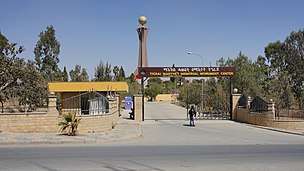
The martyrs' memorial monument pays respects to the over 60,000 TPLF fighters who died and over 100,000 fighters who were injured in the overthrow of the marxist Derg regime in 1991. The monument is 51 metres (167 ft) tall and is located in Adi-Haki sub-city. The monument has many sculptures depicting the struggle of the peasants and fighters against the Derg soldiers.[14]
Emperor Yohannes IV in the 19th century became Negus and built a castle and Ethiopian Orthodox Tewahedo churches in the city.[2] The castle was constructed by Ethiopian engineer Lij Ingidashet and Italian engineer Giacomo Naretti.[15][16] The castle complex now serves as a museum, where the Emperor's throne, royal bed, ceremonial dress, rifles, and many other valuable historical collections, can be seen.
Other notable landmarks include the churches Enda Gabir, Enda Yesus Mekelle Bete Mengist, Mekelle Iyesus, Mekelle Maryam, Mekelle Selassie, Enda Mariam Bugsa[17] and Mekelle Tekle Haymanot.
Sports
Mekelle City FC and Dedebit F.C are the local football teams from the city; both have been competing in the Ethiopian Premier League. A local market has been held every Monday since at least 1890.
Geography
Mekelle lies at an elevation of 2,254 metres (7,395 ft) above sea level (at the airport), close to the edge of the northern portion of the Ethiopian Rift Valley, on a Jurassic limestone plateau, in a semi-arid area with a mean annual rainfall of 714 millimetres (28.1 in).[18] Except for a moderately dense eucalyptus cover on the hills in eastern edges of Mekelle and some exotic species of trees and shrubs lining the streets, the surrounding landscape is almost treeless.
Sub-cities
Mekelle is divided into seven local administrations: Hawelti, Adi-Haki, Kedamay Weyane, Hadnet, Ayder, Semien and Quiha. Within each local administration there are kebeles or ketenas. The subcities of Mekelle comprise the area formerly incorporated as Mekelle City. While falling under the jurisdiction of Mekele Special Zone Government, each subcity is also a borough with its own administrator, like other cities of Ethiopia. These officials oversee socio-economic development and run health, education, and utilities.[19]
The subcities differ from other cities in having a unique administrative relationship with the regional government. Certain municipal functions, such as waterworks, sewerage, and fire-fighting, are handled by the Mekelle Government. To pay for the added administrative costs, the prefecture collects municipal taxes, which would usually be levied by the city. The "three central subcities" of Mekelle – Kedamay Weyane, Ayder and Hawelti – are the business core of the city, with a daytime population more than seven times higher than their nighttime population. Semien is unique occupied by many major factories. It is often called the "economic center" of the Tigray.
Mekelle special zone has been represented in the House of Peoples' Representatives by Addis Alem Balema since 2005.[20] The mayor of Mekelle is Daniel Assefa.
The city council is Mekelle's legislative body and the city is administrated by a mayor (Daniel Assega) and seven local administrators.
Climate
The climate in this area is characterized by relatively high temperatures year-round and distinct wet and dry seasons. The Köppen type for this climate is tropical savanna climate (Aw) as all months average above 18 °C or 64.4 °F; however it borders on a humid subtropical climate (Cwa). In the area to the northeast of Mekelle, a more dry climate, the "warm semi-arid climate" (Bsh) is to be found.
| Climate data for Mek'ele | |||||||||||||
|---|---|---|---|---|---|---|---|---|---|---|---|---|---|
| Month | Jan | Feb | Mar | Apr | May | Jun | Jul | Aug | Sep | Oct | Nov | Dec | Year |
| Average high °C (°F) | 23 (73) |
24 (75) |
25 (77) |
26 (79) |
27 (81) |
27 (81) |
27 (80) |
23 (73) |
25 (77) |
24 (75) |
23 (73) |
22 (72) |
24.3 (75.8) |
| Daily mean °C (°F) | 19.5 (67.1) |
20.5 (68.9) |
21.5 (70.7) |
22.5 (72.5) |
23.5 (74.3) |
23.5 (74.3) |
20.5 (68.9) |
20.0 (68.0) |
21.5 (70.7) |
20.5 (68.9) |
19.5 (67.1) |
18.5 (65.3) |
20.9 (69.7) |
| Average low °C (°F) | 16 (61) |
17 (63) |
18 (64) |
19 (66) |
20 (68) |
20 (68) |
18 (64) |
17 (63) |
18 (64) |
17 (63) |
16 (61) |
15 (59) |
17.6 (63.7) |
| Average rainfall mm (inches) | 36 (1.4) |
10 (0.4) |
25 (1) |
46 (1.8) |
36 (1.4) |
30 (1.2) |
200 (7.9) |
220 (8.5) |
36 (1.4) |
10 (0.4) |
30 (1.2) |
41 (1.6) |
720 (28.2) |
| Source: Weatherbase[21] | |||||||||||||
Demographics
There were about 5,000 inhabitants in 1935.
In 1938, the town counted approximately 12,000 inhabitants (including 100 Italians).[11]
Based on the 2007 Census conducted by the Central Statistical Agency of Ethiopia (CSA), this town has a total population of 215,914 people (104,925 men and 110,989 women). The two largest ethnic groups reported in Semien Mi'irabawi were the Tigray (96.2%), and Amhara (2.26%); all other ethnic groups made up 1.54% of the population. Tigrinya is spoken as a first language by 95.55%, and Amharic by 3.18%; the remaining 1.27% spoke all other primary languages reported. 92.68% of the population said they were Orthodox Christians, and 6.03% were Muslim.[22]
The 1994 national census reported the population of Mekelle as 96,938 people (45,729 men and 51,209 women). The two largest ethnic groups reported were the Tigrayan (96.5%), the Amhara (1.59%), foreigners from Eritrea (0.99%); all other ethnic groups made up 0.98% of the population. Tigrinya was spoken as a first language by 96.26%, and 2.98% spoke Amharic; the remaining 0.76% spoke all other primary languages reported. 91.31% of the population practiced Ethiopian Orthodox Christianity, and 7.66% were Muslim. Concerning education, 51.75% of the population were considered literate, which is more than the Zone average of 15.71%; 91.11% of children aged 7–12 were in primary school; 17.73% of the children aged 13–14 were in junior secondary school; and 52.13% of the inhabitants aged 15–18 were in senior secondary school. Concerning sanitary conditions, about 88% of the urban houses had access to safe drinking water at the time of the census, and about 51% had toilet facilities.[23]
Economy
Mekelle is one of Ethiopia's principal economic and educational centers.
Manufacturing
Local industry includes Mesfin Industrial Engineering, a steel fabrication and manufacturing factory, which also has car assembly line and Messebo Cement Factory, northern Ethiopia's principal cement production facility. Both companies are owned and managed by the Endowment Fund for the Rehabilitation of Tigray (EFFORT).[24]
The $100 million Mekelle Industrial park hosts many foreign textiles companies and employs approximately 20,000 people.
Services
There has been a boom in hotel services for tourism and conferences due to predominant place Mekelle holds in northern Ethiopia. The development of healthcare services has greatly aided in improving the quality of life of Mekelle's inhabitants. A $3.5 million modern referral public health laboratory was constructed by the US CDC to serve as a training site as well as providing quality assurance for Tigray's hospitals and medical laboratories.[25]
Agriculture
Mekelle is surrounded by agrarian villages that sell their crops to the urban population in the markets. Traditionally there is a market on Saturday and Monday where a wide variety of produce and livestock is available for sale, in addition to salt from Afar.
Livestock
The Abergelle Slaughterhouse, funded by the Dejenna Endowment, began operations in late 2008.[26]
Transport
Mekelle is linked by all weather roads to Addis Ababa and Aksum, and has an airport, Ras Alula Aba Nega International Airport (ICAO code HAMK, IATA MQX). Intercity bus service is provided by the Selam Bus Line Share Company, and its city bus service is provided by Amora buses.
Mekelle is the terminal station of the electric Weldiya-Mekelle railway (under construction), connecting Mekelle with Addis Ababa and Djibouti.
Education
Publicly run kindergartens, elementary schools (years 1 through 6), and junior high schools (7 through 9) are operated by local wards or municipal offices. Public high schools in Mekelle are run by the Tigray Education Bureau. Mekelle also has many private schools from kindergarten through high school.
Mekelle has several universities, junior colleges, and vocational schools. Many of Ethiopia's most prestigious universities are in Mekelle, including Mekelle University and Mekelle Institute of Technology. Nejashi Ethio-Turkish International Schools and Closys College are private schools in the city.[27]
International relations
Mekelle is a member of the Millennium Cities Initiative.
Gallery
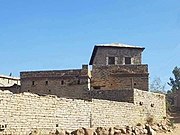 ታሪካዊ መህል መቀለ ፩ አንድ Historic Center Mekelle 1 ʾänd one
ታሪካዊ መህል መቀለ ፩ አንድ Historic Center Mekelle 1 ʾänd one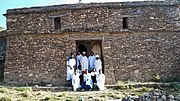 ታሪካዊ መህል መቀለ ፪ ሁለት Historic Center Mekelle 2 hulät two
ታሪካዊ መህል መቀለ ፪ ሁለት Historic Center Mekelle 2 hulät two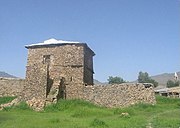 ታሪካዊ መህል መቀለ ፫ ሶስት Historic Center Mekelle 3 sost three
ታሪካዊ መህል መቀለ ፫ ሶስት Historic Center Mekelle 3 sost three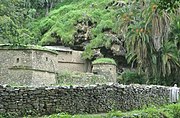 ታሪካዊ መህል መቀለ ፬ አራት Historic Center Mekelle 4 ʾärat four
ታሪካዊ መህል መቀለ ፬ አራት Historic Center Mekelle 4 ʾärat four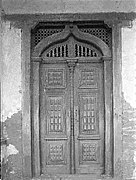 ታሪካዊ መህል መቀለ ፭ አምስት Historic Center of Mekelle 5 ʾämst five
ታሪካዊ መህል መቀለ ፭ አምስት Historic Center of Mekelle 5 ʾämst five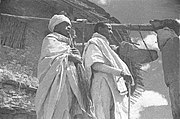 ታሪካዊ መህል መቀለ ፮ ስድስት Historic Center of Mekelle 6 sədst six
ታሪካዊ መህል መቀለ ፮ ስድስት Historic Center of Mekelle 6 sədst six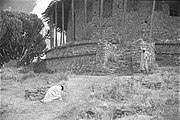 ታሪካዊ መህል መቀለ ፯ ሰባት Historic Center of Mekelle 7 säbat seven
ታሪካዊ መህል መቀለ ፯ ሰባት Historic Center of Mekelle 7 säbat seven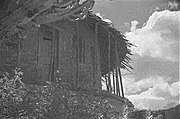 ታሪካዊ መህል መቀለ ፰ ስምንት Historic Center of Mekelle 8 səmnt eight
ታሪካዊ መህል መቀለ ፰ ስምንት Historic Center of Mekelle 8 səmnt eight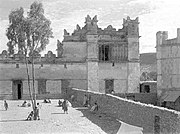 ታሪካዊ መህል መቀለ ፱ ዘጠኝ Historic Center of Mekelle 9 zäṭäñ nine
ታሪካዊ መህል መቀለ ፱ ዘጠኝ Historic Center of Mekelle 9 zäṭäñ nine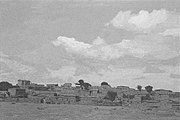 ታሪካዊ መህል መቀለ ፲ አስር Historic Center of Mekelle 10 ʾäsr ten
ታሪካዊ መህል መቀለ ፲ አስር Historic Center of Mekelle 10 ʾäsr ten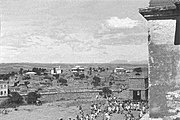 ታሪካዊ መህል መቀለ ፲፩ አስራ አንድ Historic Center of Mekelle 11 ʾäsra ʾänd eleven
ታሪካዊ መህል መቀለ ፲፩ አስራ አንድ Historic Center of Mekelle 11 ʾäsra ʾänd eleven
See also
References
- The 2015/16 Ethiopian Household Consumption – Expenditure (HCE) Survey. Federal Democratic Republic of Ethiopia Central Statistical Agency. p. 42. Archived from the original on 6 June 2018. Retrieved 26 August 2018.
- Aberra, Yohannes (2007). "Mäqälä". In Uhlig, Siegbert (ed.). Encyclopaedia Aethiopica. Wiesbaden: Harrassowitz Verlag.
- Taddesse, Madhane (1995). Salt, Trade and Urbanization: the Story of Mäqälä Town, 1872-1935. Addis Ababa: Addis Ababa University.
- Sakkwar, Taddese (2000). የመቀሌ ከመሰራረትና እድገት [Foundation and Growth of Mäqälä Town]. Mekelle.
- Asfaw, Girmaselassie; Pankhurst, Richard (1979). Tax Records of and Inventories of Emperor Tewodros of Ethiopia, 1855-1868. London: University of London. ISBN 0728600579.
- https://core.ac.uk/download/pdf/145777879.pdf
- https://www.tandfonline.com/doi/pdf/10.3130/jaabe.10.343
- http://documents1.worldbank.org/curated/es/201961468257059831/pdf/E18440V120AFR00Box385213B00PUBLIC0.pdf
- Gebrelibanos, Tsegay (2009). "The Ethiopian Salt Trading System in the 20th Century: A View from Mäqäla, Northern Ethiopia". Proceedings of the 16th International Conference of Ethiopian Studies: 185–201.
- Montegazza, Vico (1896). Gl'Italiani in Africa: l'assedio di Macallè. Firenze: Successori Le Monnier.
- Consociazione turistica Italiana. Guida dell'Africa orientale Italiana. Milano. p. 302.
- Gilkes, Patrick (1975). The Dying Lion: Feudalism and Modernization in Ethiopia. London: St. Martin's Press. pp. 180, 188.
- "UN Mission in Ethiopia and Eritrea is withdrawn". UNMEE. 30 July 2008. Retrieved 29 September 2018.
- "Martyrs Memorial Munument". Tigray Martyrs’ Memorial Monument Center. 2015. Retrieved 13 March 2018.
- "Local History in Ethiopia" (pdf) The Nordic Africa Institute website (accessed 6 January 2008)
- Narétti, James entry (in Italian) by Carlo Zaghi in the Enciclopedia italiana
- "Photographs of the city of Mekelle". Independent Travellers. independent-travellers.com. Retrieved March 15, 2018.
- Britannica, Mekele, britannica.com, USA, accessed on January 5, 2020
- Habtu, Adonay (2011). Popular Participation in Decentralized Governance. Mekelle: Mekelle University. p. 29.
- Balema, Addis (2014). Democracy and Economic Development in Ethiopia. Trenton: Red Sea Press. ISBN 9781569023907.
- "Weatherbase.com". Weatherbase. 2018. Retrieved on October 30, 2018.
- Census 2007 Tables: Tigray Region Archived November 14, 2010, at the Wayback Machine, Tables 2.1, 3.1, 3.2, 3.4.
- 1994 Population and Housing Census of Ethiopia: Results for Southern Nations, Nationalities and Peoples' Region, Vol. 1, part 1 Archived November 19, 2008, at the Wayback Machine, Tables 2.1, 2.12, 2.19, 3.5, 3.7, 6.3, 6.11, 6.13 (accessed 30 December 2008)
- EFFORT website Archived 2011-06-14 at the Wayback Machine
- "U.S. Government Inaugurates New Regional Public Health Laboratory in Mekelle". US Embassy in Ethiopia. 25 May 2017.
- Cannon, Bryant (2009). Investment Opportunities in Mekelle, Tigray State, Ethiopia. New York: Millennium Cities Initiative.
- "Mekelle Branch Archived 2016-03-14 at the Wayback Machine." Nejashi Ethio-Turkish International Schools. Retrieved on October 19, 2015.
External links
| Wikivoyage has a travel guide for Mekele. |
| Wikimedia Commons has media related to Mek'ele. |
- Ethiopian Treasures - The castle of Emperor Yohannes IV
- Cities of Ethiopia: Mekelle by John Graham (Addis Tribune, 12 October 2001)
